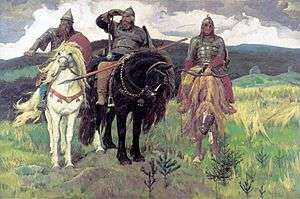Bogatyr

A bogatyr (Russian: богатырь; Old East Slavic богатырь) or vityaz (Russian: витязь) is a stock character in medieval East Slavic legends (byliny), akin to a Western European knight-errant. In modern Russian, the word is used to describe a knight, a warrior or, figuratively, a strong person.
Etymology
Bogatyr is derived from baghatur, a historical Turco-Mongol honorific title.[1][2] The etymology of this word is uncertain, although the first syllable is very likely the Iranian word *baγ "god, lord".[3]
An early non-Russian usage of the word bogatyr was recorded in Sernitskiy's book Descriptio veteris et novae Poloniae cum divisione ejusdem veteri et nova, (A description of the Old and the New Poland with the old, and a new division of the same,) printed in 1585 at an unknown location, in which he says, "Rossi… de heroibus suis, quos Bohatiros id est semideos vocant, aliis persuadere conantur." ("Russians... try to convince others about their heroes whom they call Bogatirs, meaning demigods.")
Overview
Many Rusian epic poems, called Bylinas, prominently featured stories about these heroes, as did several chronicles, including the 13th century Galician–Volhynian Chronicle. Some bogatyrs are presumed to be historical figures, while others, like the giant Svyatogor, are purely fictional and possibly descend from Slavic pagan mythology.
Many of the stories about bogatyrs revolve around the court of Vladimir I of Kiev (958–1015). There served the most notable bogatyrs or vityazes: the trio of Alyosha Popovich, Dobrynya Nikitich and Ilya Muromets. Each of them tends to be known for a certain character trait: Alyosha Popovich for his wits, Dobrynya Nikitich for his courage, and Ilya Muromets for his physical and spiritual power and integrity, and for his dedication to the protection of his homeland and people. Most of those bogatyrs adventures are fictional, and often included fighting dragons, giants and other mythical creatures. However, the bogatyrs themselves were often based on real people. Historical prototypes of both Dobrynya Nikitich (the warlord Dobrynya) and Ilya Muromets are proven to have existed.
The Novgorod Republic produced a specific kind of hero, an adventurer rather than a noble warrior. The most prominent examples were Sadko and Vasili Buslayev.
Later notable bogatyrs also include those who fought by Alexander Nevsky's side and those who fought in the Battle of Kulikovo.
Epic bogatyrs

- Ilya Muromets, regarded as the greatest of the bogatyrs, from Murom
- Dobrynya Nikitich – from Ryazan (based on a historical warlord of Vladimir I)
- Alyosha Popovich – from Rostov
- Svyatogor, a giant knight who bequeath his strength to Ilya Muromets (purely fictional)
- Gavrila Alexich of Novgorod, who served Alexander Nevsky in Battle of Neva (historical)
- Ratmir of Novgorod, who served Alexander Nevsky in Battle of Neva (historical)
- Vasili Buslayev of Novgorod
- Peresvet, who sacrificed himself against the Tatars at the Battle of Kulikovo (historical)
- Anika the Warrior
- Duke Stepanovich
- Dunaj Ivanovich
- Volga Svyatoslavovich (possibly based on Oleg of Novgorod)
- Sukhman The Bogatyr
- Nikita the Furrier
- Mikula Selyaninovich ("Mikula the Villager's Son")
Bogatyrs in films
- Films by Alexander Ptushko:
- Sadko (Садко, 1952)
- Ilya Muromets (Илья Муромец, 1956)
- Ruslan and Ludmila (Руслан и Людмила, 1972), based on a fantasy poem of the same name by Alexander Pushkin.
- Soyuzmultfilm animated films (directed by Ivan Aksenchuk):
- Ilya Muromets (1975)
- Ilya Muromets and Nightingale the Robber (1978)
- Melnitsa Animation series "The Three Bogatyrs":
- Alyosha Popovich and Tugarin the Serpent (Алёша Попович и Тугарин Змей, 2004)
- Dobrynya Nikitich and Zmey Gorynych (Добрыня Никитич и Змей Горыныч, 2006)
- Ilya Muromets and Nightingale the Robber (Илья Муромец и Соловей-Разбойник, 2007)
- The Three Bogatyrs and Shamakhan Queen (Три богатыря и Шамаханская царица, 2010)
- The Three Bogatyrs on Distant Shores (Три богатыря на дальних берегах, 2012)
- Other films:
- Alexander Nevsky (Александр Невский, 1938) by Sergei Eizenshtein. Although based on real history, the film also shows a strong bylina influence and features bylina bogatyr Vasily Buslayev as a secondary character.
- The Battle of Kerzhenets (1971)
- Prince Vladimir (Князь Владимир, 2006)
See also
| Wikimedia Commons has media related to Bogatyr. |
- Bylina, East Slavic epic poetry
- Victor Vasnetsov (1848–1926), Russian folk revivalist painter, famous for his depictions of bogatyrs.
- Knight-errant
- Slavic mythology
References
Citations
Sources
- Beckwith, Christopher I. (16 March 2009). Empires of the Silk Road: A History of Central Eurasia from the Bronze Age to the Present. Princeton University Press. ISBN 0691135894. Retrieved 30 May 2015.
- Богатыри и витязи Русской земли: По былинам, сказаниям и песням. (1990) Moscow: "Moskovsky Rabochy" publishers (Russian)